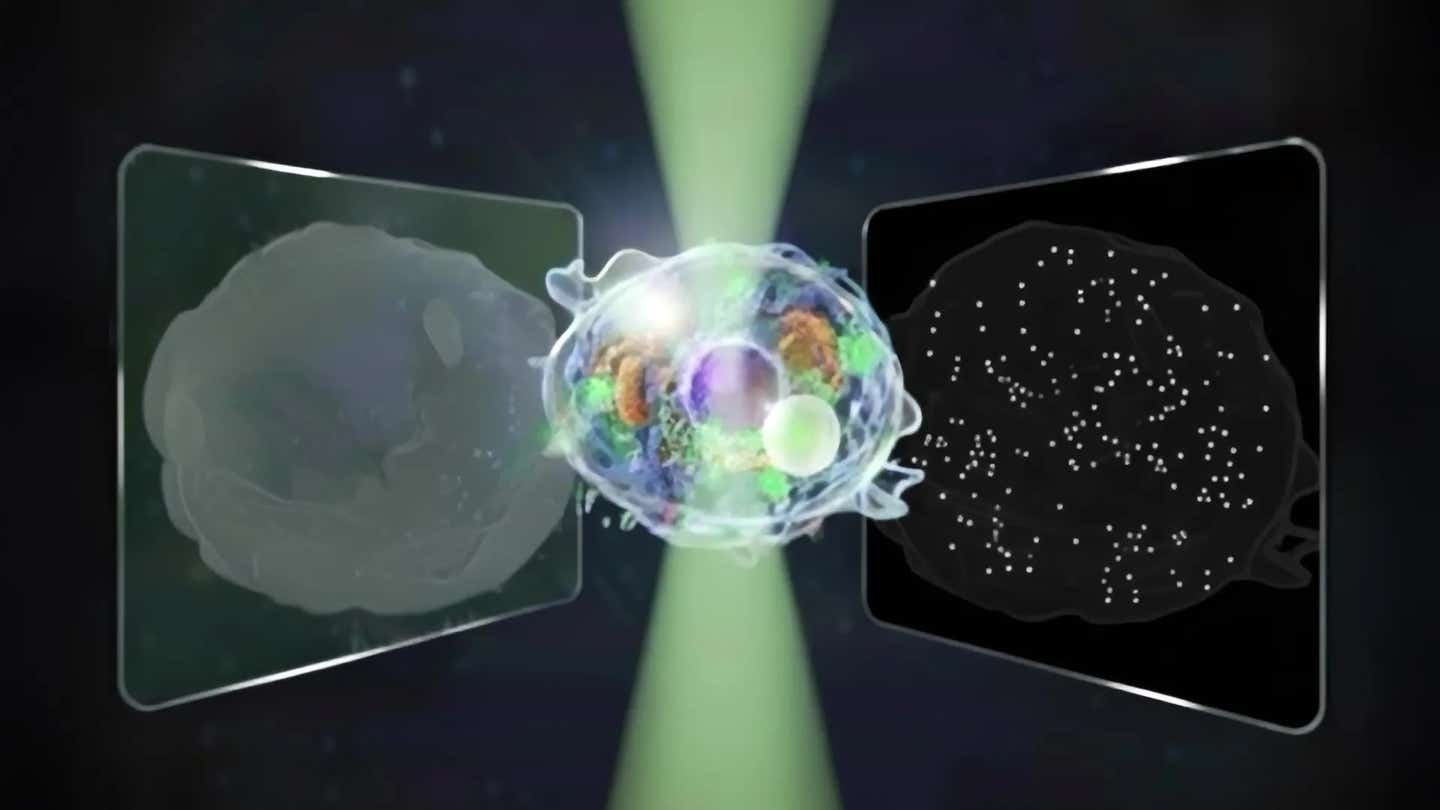New discovery paves the way for stamp-sized hard drives with 100x more storage
A new magnetic molecule stores data up to 100K, breaking records and opening paths to next-gen, ultra-dense data storage systems.

A tiny, next-gen chip no larger than a postage stamp could hold 100 times more data than today’s storage devices. (CREDIT: CC BY-SA 4.0)
Researchers have created a molecule that can store magnetic data at record-high temperatures, potentially reshaping how digital information is archived. The molecule, based on the rare earth element dysprosium, can retain its magnetic memory up to 100 Kelvin, or about minus 173 degrees Celsius.
The findings, published in Nature, could pave the way for next-generation hardware about the size of a postage stamp that can store 100 times more digital data than current technologies.
Building Better Magnets With Atoms
Magnetic memory in molecules has been a goal for years. While traditional hard drives use clusters of atoms to store bits of data, single-molecule magnets can work alone, promising higher storage density. Until recently, these magnets only worked at very low temperatures. The best examples stopped working above 80 Kelvin. But a new molecule has pushed that limit to 100 Kelvin.
The key lies in the design. Scientists from The University of Manchester and the Australian National University built a compound called 1-Dy, where dysprosium is bonded between two nitrogen atoms. They added a flexible chemical group, an alkene, that pins the structure into a nearly straight line. This alignment increases the magnetic strength of the molecule. The longer the structure stays straight, the more stable the magnetic memory becomes.
This straight line creates what physicists call strong "magnetic anisotropy." It means the molecule prefers to align in one direction, like a compass needle. That alignment helps resist random movements that erase memory, especially as temperature increases. Calculations show the alkene limits unwanted side forces, keeping the molecule stable.
Testing and Simulating the New Magnet
To make the molecule, researchers used a multistep process involving rare earth chemistry. They created the dysprosium molecule and a similar one using yttrium, a non-magnetic element, as a control. Nuclear magnetic resonance tests and X-ray scans confirmed the structure. Simulations helped predict the molecule’s behavior before it was tested.
Related Stories
Computational models used supercomputers in Australia to simulate the molecule’s spin behavior over time. These spin dynamics, governed by quantum mechanics, help explain how long magnetic memory can last. The calculations showed the new compound has an energy barrier of 1,843 cm–1, the highest yet recorded for a dysprosium-based single-molecule magnet.
The energy barrier controls how hard it is for the magnetic direction to flip. A higher barrier means better memory at higher temperatures. These tests matched well with predictions, proving the molecule's stability.
Comparing With Previous Records
Before 1-Dy, the best single-molecule magnets had limits around 80 Kelvin. One widely studied example, known as Dy(Cpttt)2, reached about 1,237 cm–1. The new compound not only raised this limit but also demonstrated slower magnetic reversal rates above 90 Kelvin, up to 100 times slower than earlier examples.
To confirm these results, the team tested magnetic hysteresis—a way to measure how well a magnet keeps its memory. The molecule kept its magnetic state up to 100 Kelvin, slowly releasing it only at higher temperatures. While the magnetic strength was lower than in some other materials, the fact that it held on for so long at a relatively warm temperature was remarkable.
Below 10 Kelvin, the molecule's magnetic state reversed through quantum tunneling, a quantum effect where the spin flips without climbing the energy barrier. At higher temperatures, the flips occurred through interactions with atomic vibrations, or phonons, via a process called the Raman mechanism. These effects were analyzed using high-precision tools.
Toward High-Density Data Storage
The discovery holds real promise for future storage devices. Professor Nicholas Chilton, co-lead author from ANU, explained that the molecule could eventually store up to three terabytes of data per square centimeter. That’s about 40,000 CDs packed into a space the size of a postage stamp.
More than ever, society needs efficient data storage. Every online search, video stream, and uploaded file adds to global demand. Current technologies may struggle to keep up. Single-molecule magnets could be part of the solution. They don't rely on clusters of atoms and can be scaled down to nanoscopic levels.
Although 100 Kelvin is still far from room temperature, it's a major step forward. Most commercial data centers already use cooling systems. Liquid nitrogen, which cools to 77 Kelvin, is cheap and readily available. That makes 1-Dy potentially usable in large-scale storage infrastructure.
Professor David Mills from Manchester added that the molecule’s magnetic properties bring us closer to real-world use. While mobile phones won’t be using this tech anytime soon, giant servers and cloud systems might.
Looking Ahead: Engineering Even Better Molecules
Researchers believe this discovery is only the beginning. The alignment of dysprosium between two nitrogen atoms, made stable by the alkene pin, may serve as a design model for future magnets. By using ligands that reduce low-energy vibrations, it might be possible to further slow spin dynamics and raise the temperature threshold even more.
The current molecule is already remarkable. But the team is exploring ways to enhance it. They plan to test more linear molecules, with angles closer to 180 degrees, and use ligands with higher negative charge. These changes could help create magnets that store memory at even higher temperatures, possibly at room temperature someday.
The study also shows that the behavior of magnetic molecules depends not just on structure but also on how vibrations and phonons interact with electronic spins. By simulating spin-phonon coupling at various temperatures and fields, researchers were able to predict and confirm hysteresis behavior.
Spin dynamics calculations, extending to non-zero magnetic fields, helped confirm that 1-Dy stays magnetized up to 100 Kelvin. These findings point to new strategies for designing magnetic materials that resist thermal noise.
As digital storage becomes more important, from social media to artificial intelligence, breakthroughs like this open the door to new technologies. The molecule 1-Dy, born from creative chemistry and advanced physics, offers a glimpse into the future of data.
Note: The article above provided above by The Brighter Side of News.
Like these kind of feel good stories? Get The Brighter Side of News' newsletter.



